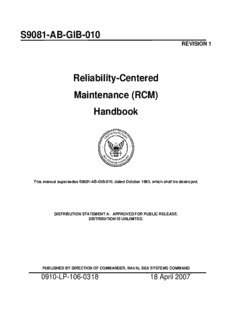
S9081-AB-GIB-010 Reliability-Centered Maintenance (RCM PDF
Preview S9081-AB-GIB-010 Reliability-Centered Maintenance (RCM
S9081-AB-GIB-010 REVISION 1 Reliability-Centered Maintenance (RCM) Handbook This manual supersedes S9081-AB-GIB-010, dated October 1983, which shall be destroyed. DISTRIBUTION STATEMENT A: APPROVED FOR PUBLIC RELEASE. DISTRIBUTION IS UNLIMITED. PUBLISHED BY DIRECTION OF COMMANDER, NAVAL SEA SYSTEMS COMMAND 0910-LP-106-0318 18 April 2007 S9081-AB-GIB-010 FORWARD If you require assistance, contact distance support (anchor desk) via the web http://www.anchordesk.navy.mil/) and via the toll free number (1-877-4-1-TOUCH [86824]). Ships, training activities, supply points, depots, Naval Shipyards and Supervisors of Shipbuilding are requested to arrange for the maximum practical use and evaluation of NAVSEA technical manuals. All errors, omissions, discrepancies, and suggestions for improvement to NAVSEA technical manuals shall be forwarded to: COMMANDER CODE 310 TMDER, BLDG 1388 NAVSURFWARCENDIV NSDSA 4363 MISSILE WAY PORT HUENEME CA 93043-4307 on NAVSEA Technical Manual Deficiency/Evaluation Report, form NAVSEA 4160/1. All feedback comments shall be thoroughly investigated and originators will be advised of action resulting there from. Three copies of NAVSEA 4160/1 are included at the end of each separately bound technical manual 8-1/2 x 11 inches or larger. Copies of form NAVSEA 4160/1 may be downloaded from: https://nsdsa2.phdnswc.navy.mil/tmmp/forms/TMDER_BLANK_REV_3-2001.doc Users are encouraged to transmit deficiency submittals via the Naval Systems Data Support Activity Web page located at: https://nsdsa2.phdnswc.navy.mil/tmder/tmder.htm Urgent priority TM deficiencies shall be reported by Naval message to Port Hueneme Division, Naval Surface Warfare Center (Code 311), Port Hueneme, CA. Local message handling procedures shall be used. The message shall identify each TM deficiency by TM identification number and title. iii S9081-AB-GIB-010 —THIS PAGE INTENTIONALLY LEFT BLANK— iv S9081-AB-GIB-010 Reliability-Centered Maintenance (RCM) Handbook Contents Section Title Page 1 Introduction to RCM 1-1 1.1 Purpose 1-1 1.2 History of RCM 1-1 1.3 Basis for RCM 1-3 1.4 RCM Certification 1-4 1.5 Summary 1-5 2 Fundamentals of Maintenance 2-1 Engineering (ME) 2.1 Failures Happen 2-1 2.2 Not All Failures Have the Same 2-2 Probability 2.3 Not All Failures have the Same 2-4 Consequences 2.4 Simple Components Wear-Out, Complex 2-8 Systems Break Down 2.5 Good maintenance provides required 2-8 functionality for lowest practicable cost 2.6 Maintenance Can Only Achieve Inherent 2-9 Design Reliability 2.7 Hidden Functions Require Special 2-9 Treatment v S9081-AB-GIB-010 Reliability-Centered Maintenance (RCM) Handbook Contents Section Title Page 2.8 Unnecessary Maintenance Takes 2-10 Resources Away From Necessary Maintenance 2.9 Good Maintenance Programs Undergo 2-11 Continuous Improvement 2.10 Summary 2-13 3 What Comprises Maintenance? 3-1 3.1 Definition of Maintenance 3-1 3.2 Three Categories of Maintenance 3-2 3.3 Five Types of Preventive Maintenance 3-4 Tasks 3.4 Summary 3-10 4 The Rules of RCM 4-1 4.1 Three Hypotheses 4-1 4.2 All Maintenance Tasks Must Be 4-3 Applicable (Relevant) 4.3 All Maintenance Tasks Must Be Effective 4-4 (Have Value) 4.4 Why We Need RCM Methodology 4-5 4.5 Summary 4-5 5 Two RCM Processes 5-1 5.1 Summary 5-3 vi S9081-AB-GIB-010 Reliability-Centered Maintenance (RCM) Handbook Contents Section Title Page 6 The Classic RCM Process 6-1 6.1 Analyst Selection and Training 6-1 6.2 Information Collection 6-2 6.3 System Partitioning and Identification 6-2 6.4 Systems Analysis 6-3 6.5 The RCM Methodology 6-3 6.6 Designing an RCM-Based Preventive 6-4 Maintenance Program (MIL-P-24534A) 6.7 Phase 1: Functional Block Diagram and 6-5 the Master Systems and Subsystems Index (OPNAV Form 4790/114) 6.8 Phase 2: Functional Failure Analysis 6-7 (OPNAV Form 4790/116) 6.9 Phase 3: Additional Functionally 6-8 Significant Item Selection (OPNAV Form 4790/117) 6.10 Phase 3 Continued: Functionally 6-9 Significant Items Index (OPNAV Form 4790/118) 6.11 Phase 4: Failure Modes and Effects 6-9 Analysis (OPNAV Form 4790/119) 6.12 Phase 5: Decision Logic Tree Analysis 6-10 (OPNAV Form 4790/120) 6.13 Phase 6: Servicing and Lubrication 6-16 Analysis (OPNAV Form 4790/121) vii S9081-AB-GIB-010 Reliability-Centered Maintenance (RCM) Handbook Contents Section Title Page 6.14 Periodicity Considerations 6-16 6.15 Phase 7: Audit and Preparation of the 6-16 Maintenance Requirement: Maintenance Requirement Index (MR) (OPNAV Form 4790/123) 6.16 Phase 8: Method Study and Procedure 6-16 Evaluation for the New Tasks and Revised Maintenance Requirement Cards (MRCs) (OPNAV Form 4790/130) 6.17 Phase 9: Maintenance Requirement Task 6-17 Definition (OPNAV Form 4790/124) 6.18 Phase 10: Inactive Equipment 6-17 Maintenance (OPNAV Form 4790/129) 6.19 Phase 11: Unscheduled Maintenance 6-18 6.20 Phase 12: MRC/MIP Preparation 6-18 (OPNAV Forms 4790/82, 83, 84, and 85) 6.21 eRCM 6-18 6.22 Summary 6-19 7 The Backfit Process 7-1 7.1 Analyst Selection and Training 7-1 7.2 Information Collection 7-1 7.3 The Backfit RCM Methodology 7-2 viii
Description: